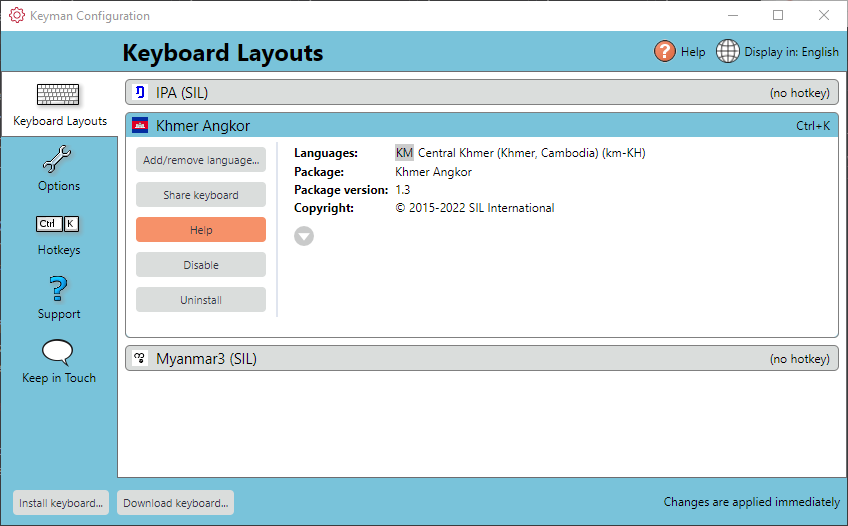Keyman Configuration - Keyboard Layouts Tab
The Keyboard Layouts tab of Keyman Configuration lists all the Keyman keyboards which are currently installed on your computer. You can use the Keyboard Layouts tab to install and uninstall keyboards, enable and disable keyboards, set keyboard hotkeys, show keyboard help and view keyboard details.

Opening the Keyboard Layouts Tab
To open the Keyboard Layouts tab of Keyman Configuration:
-
Click on the Keyman icon
 , on the
Windows Taskbar near the clock.
, on the
Windows Taskbar near the clock. -
From the Keyman menu, select Configuration....
-
Select the Keyboard Layouts tab.
Tip: Keyman Configuration opens in the same tab you last closed it in.
Installing a Keyboard
To install a keyboard layout in Keyman, see: Installing a Keyman Keyboard within Keyman
Uninstalling a Keyboard
To uninstall a Keyman keyboard from the Keyboard Layouts tab of Keyman Configuration, see: Keyboard Task - Uninstall a Keyboard
Enabling and Disabling a Keyboard
To enable or disable a Keyman keyboard from the Keyboard Layouts tab of Keyman Configuration, see: Keyboard Task - Enable or Disable a Keyboard
Setting a Hotkey
The Hotkey for selecting a keyboard will appear to the right of the keyboard name. If the keyboard has more than one language associated with it then the hotkey will appear beside the language in the keyboards details list.
-
Click the hotkey link beside the keyboard or language. The Change Hotkey dialog box will be displayed.

-
Select a default hotkey or click Custom and type the hotkey you wish to use.
Note: If you press a single letter or Shift plus a single letter, the hotkey will default to Ctrl + Alt plus the letter you pressed, in order to avoid conflicts with standard keyboard input.
Note: To clear a hotkey that has been set previously, click Clear Hotkey or press Backspace.
Note: Be aware that you can set the hotkey to replace common Windows hotkeys ( Ctrl + C, Ctrl + V, etc). This is not recommended.
-
Click OK to save your selection.
The new hotkey will now be available.
The hotkeys can also be set for a Keyman keyboard, using the Hotkeys tab.
Showing Introductory Help
To show introductory help for a Keyman keyboard from the Keyboard Layouts tab of Keyman Configuration:
-
Select the keyboard name from the keyboard list to expand options associated with it.
-
Click on the help button and the help documentation will be shown.

Viewing Keyboard Details
To view details for a Keyman keyboard from the Keyboard Layouts tab of Keyman Configuration:
-
Find a keyboard in the keyboard list.
-
Select the keyboard name from the keyboard list to expand options associated with it. The keyboard information window will expand.
 The initial drop down has the following information if available:
The initial drop down has the following information if available:- Languages associated with the keyboard
- Keyboard package name
- Keyboard package version number
- Copyright details
-
Click on the down arrow
 , at the end of the list will reveal
further details including:
, at the end of the list will reveal
further details including:- Keyboard version number
- Keyboard filename.
- Keyboard included fonts
- Keyboard encodings
- Keyboard layout type
- On Screen Keyboard status
- Documentation status
- Keyboard Message

Sharing a keyboard with other users and devices
If you installed a keyboard layout using the Download keyboard button, then you can share the keyboard with other devices and users using a QR Code.
-
Expand the keyboard details for the keyboard you wish to share, and click the Share keyboard button.
-
A popup will appear with a QR Code. This QR Code can be scanned with a mobile phone camera to automatically open a web page with a download link to install the keyboard.

Associating a keyboard with a Windows language
All Keyman keyboards are associated with a Windows language by default. To change the association, or add a new association, see the following:




